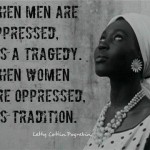Having lived through the Civil Rights movement which splintered black and white, the media promotion of the Red and Blue states which separated the nation, the most profound reaction of a movement has come from Women’s Liberation which fabricated a rift between mothers, career women and those who want it all (in addition to thoroughly confusing men). Infighting among women has stalled their progress in the workplace, in finance, status, appreciation and respect for the past ten years as well as pitting women against women who choose different life paths. What happened to us?
Leave it to wars to transform women’s lives. When men create wars, women became multi-taskers holding positions as mothers, homemakers and workers. During the Civil War, women managed the plantations or were soldiers. During WWII because of the lack of men and need for products and services, women found their rightful place as talented, intelligent providers. In the military, they were WACS, WAVS and pilots; on the assembly line, engineers, riveters and machinists. Even in the domain of strategic planning, mathematical and scientific women ran the new computer technologies. It was at this time that Day Care was born to care for the children abandoned by working moms.
However, when war is over, the productive women were expected to go back to their lives as home makers and moms. After experiencing the respect, fulfillment of the workplace contrasted by the unappreciation of at-home-mothering, this was no longer enough for them. Thus the movement, which had been percolating for generations, took hold with women’s desire to vote, participate, work and have the same rights and privileges as men. How have women behaved with these newfound freedoms and feelings?
The postwar television broadcasts were propaganda-filled with subliminal messaging for women to again feel satisfied in the home. Father Knows Best, Leave It to Beaver portrayed the ‘typical’ American family where mama stayed home, dad worked and problems were solved in 25 minutes. However, subliminal messaging travels only so far in reality. With more and more women in the workplace, thinking and believing, we could ‘have it all’- career, marriage, family, and housekeeping- many of us, myself included, were asking more and more of the men on the home front. Having been enculturated to believe they should be sole breadwinners, men did not know what to do with such requests, longing for the days of Ozzie and Harriett. Many of us thought, “I’m doing it all, what do I need a man for?” And the divorce rate skyrocketed. The rift between those that chose non-traditional routes were ostracized, chastised or dismissed as rebels and heretics while some of those who stayed home felt resentful and jealous. Then Phyllis Shaffley and Gloria Steinem became figure heads for opposition camps.
My first-hand account of this division came during my divorce in Pennsylvania. The courtroom was filled with all females (excluding my ex-husband) judge and both prosecuting attorneys. When the judge discovered I wanted to home school my children, illegal at the time in Pennsylvania and punishable with prison sending the child into foster care, she made her beliefs known. As a licensed educator, I was qualified and beyond reproach in this regard. However, to thwart my wishes, the judge wielded her authority meshed with her opinions about women into two important and telling decisions: 1) to equate my degrees with a potential salary and earnings therefore, leaving me without child support in order to ‘persuade’ me to join in the workforce instead of caring for children at home. 2) She felt my sanity was off and sent me to a female psychiatrist to determine my mental stability. Really! Both women had no idea that as a practitioner myself, it was easy to observe the tactics used to ‘break me’. The psychiatrist scheduled me for 10PM appointments in the hopes of finding me tired and exhausted and ready to fold. However, as luck would have it, I discovered her Achilles’ heal and turned the tide. Each of the women in this scenario had strong beliefs about mother’s working, children being socialized, at home mothering while demonstrating a sense of guilt and animosity for not staying home themselves.
Using power and force, it felt like they intended to bridle me into conformity and colluding in their guilt. I was saddened by this display of projection and yet understood it as a representation of the conflict women feel every day. Why are we treating each other this way? Why are we unwilling to accept that some women want to stay at home to parent while others want to work or that others want both? Why are women unsupportive of each other?
In a nation where more than 50% of children are raised by single mothers, the rhetoric and delusion of political debate on all fronts reflects a desire to return to some ideology of the ‘good-ole-days’ that do not and never did exist. The past is nostalgic but unrealistic. Therefore, a new paradigm for mothering, parenting, career, work scheduling and defining family must become a national debate and dialogue. Several women have been prominent in the news lately discussing these issues like the #2 woman at Facebook Sheryl Sandberg with her movement Lean In for women in business and Marissa Mayers, CEO of Yahoo. However, Sheryl is a billionaire and married to a millionaire and Marissa equally as wealthy enabling them to hire home and child care, unrepresentative of the majority of the female population. Yet, their premise of women needing to exert assertiveness to ask for raises, more responsibility and feeling worthy, are enculturation characteristics in which all women are familiar and must transform.
Women bring a different set of values and skills to the workplace than men. If women can rally in agreement that a new paradigm is necessary for workplace design and scheduling, for mother’s in the workplace to secure women’s health and happiness and that of their children, then the changes needed in all levels of the infrastructure of ‘work, family, child rearing’ can evolve for modern society. The ‘traditional work schedule’ of 9 to 5 in a building with four walls was instituted by men who had women at home. I designed my businesses, as many entrepenurial women do, around my children. A new model is necessary that incorporates women in the workplace especially mothers- be it home or office- where women can be close to their children during the formative years to allay the enormous guilt factor that ALL mother’s feel ( as well as form bonding and stability for the child). This will also fulfill the desire to participate in the social fabric of the nation, culture and society in meaningful ways.
Redefining family in terms of reality, again not the nostalgic interpretation, will also be valuable. Family in a few modern homes is at-home-mom with dad at work. It is more preciously, two men, two women, single mom or dad with very few parents opting for marriage, much less stay-at-home. Women delay children during child bearing years in order to gain status, job recognition and placement instead of going into the workforce and raising children as a natural organic flow of life. In addition, having served women for several decades, the ‘guilt factor’ is rampant among mom’s who feel gut wrenching agony over leaving young children to strangers while screaming and crying all the way home and back. A new model that accommodates mom at work, face time with young children, whatever that may look like, would benefit both child and mom. And women would have more incentives to workforce achievements and be less inclined to judge each other on choices.
The new paradigm must be explored, implemented and evaluated for effectiveness. Something needs to start, even though it may not be perfect, and modified as time progresses. Highly valuing mothers, Scandinavian countries have solved a multitude of problems (parental guilt, respect, appreciation, financial support, child behavior problems, and decline in prison populations) by paying mother’s to stay home for up to the first six years of a child’s life. Many companies in the US and abroad have flex hours or day cares in the business. Modern corporate models like Google and Facebook have a broader perspective of the workplace atmosphere, scheduling and work climate. When a new model of ‘the work day’ becomes commonplace, when mother’s are able to spend more face time with young children, when women start behaving like leaders and not like men, the division between women will no longer have a foundation in animosity. Women need support groups that encourage them to speak up, enable the feminine side to emerge and polish the skills that have enabled women like me to be successful in the workplace.

